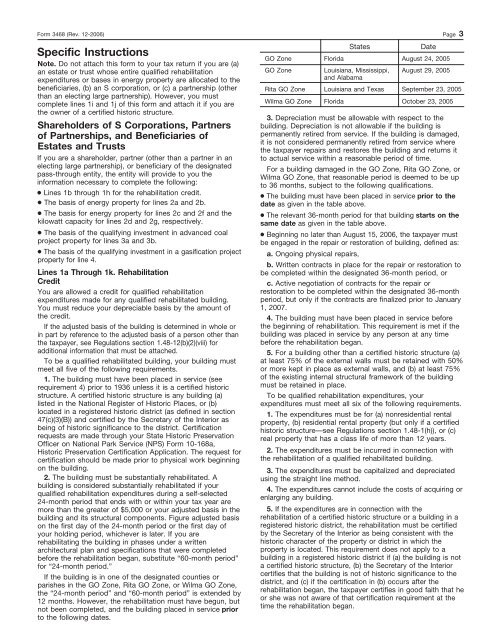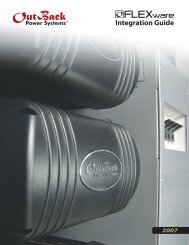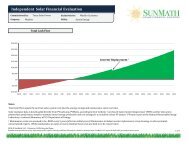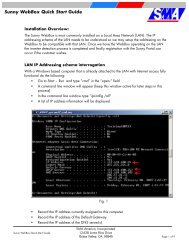THANK YOU for contacting Texas Solar Power Company. We ...
THANK YOU for contacting Texas Solar Power Company. We ...
THANK YOU for contacting Texas Solar Power Company. We ...
You also want an ePaper? Increase the reach of your titles
YUMPU automatically turns print PDFs into web optimized ePapers that Google loves.
Form 3468 (Rev. 12-2006) Page 3<br />
Specific Instructions<br />
Note. Do not attach this <strong>for</strong>m to your tax return if you are (a)<br />
an estate or trust whose entire qualified rehabilitation<br />
expenditures or bases in energy property are allocated to the<br />
beneficiaries, (b) an S corporation, or (c) a partnership (other<br />
than an electing large partnership). However, you must<br />
complete lines 1i and 1j of this <strong>for</strong>m and attach it if you are<br />
the owner of a certified historic structure.<br />
Shareholders of S Corporations, Partners<br />
of Partnerships, and Beneficiaries of<br />
Estates and Trusts<br />
If you are a shareholder, partner (other than a partner in an<br />
electing large partnership), or beneficiary of the designated<br />
pass-through entity, the entity will provide to you the<br />
in<strong>for</strong>mation necessary to complete the following:<br />
● Lines 1b through 1h <strong>for</strong> the rehabilitation credit.<br />
● The basis of energy property <strong>for</strong> lines 2a and 2b.<br />
● The basis <strong>for</strong> energy property <strong>for</strong> lines 2c and 2f and the<br />
kilowatt capacity <strong>for</strong> lines 2d and 2g, respectively.<br />
● The basis of the qualifying investment in advanced coal<br />
project property <strong>for</strong> lines 3a and 3b.<br />
● The basis of the qualifying investment in a gasification project<br />
property <strong>for</strong> line 4.<br />
Lines 1a Through 1k. Rehabilitation<br />
Credit<br />
You are allowed a credit <strong>for</strong> qualified rehabilitation<br />
expenditures made <strong>for</strong> any qualified rehabilitated building.<br />
You must reduce your depreciable basis by the amount of<br />
the credit.<br />
If the adjusted basis of the building is determined in whole or<br />
in part by reference to the adjusted basis of a person other than<br />
the taxpayer, see Regulations section 1.48-12(b)(2)(viii) <strong>for</strong><br />
additional in<strong>for</strong>mation that must be attached.<br />
To be a qualified rehabilitated building, your building must<br />
meet all five of the following requirements.<br />
1. The building must have been placed in service (see<br />
requirement 4) prior to 1936 unless it is a certified historic<br />
structure. A certified historic structure is any building (a)<br />
listed in the National Register of Historic Places, or (b)<br />
located in a registered historic district (as defined in section<br />
47(c)(3)(B)) and certified by the Secretary of the Interior as<br />
being of historic significance to the district. Certification<br />
requests are made through your State Historic Preservation<br />
Officer on National Park Service (NPS) Form 10-168a,<br />
Historic Preservation Certification Application. The request <strong>for</strong><br />
certification should be made prior to physical work beginning<br />
on the building.<br />
2. The building must be substantially rehabilitated. A<br />
building is considered substantially rehabilitated if your<br />
qualified rehabilitation expenditures during a self-selected<br />
24-month period that ends with or within your tax year are<br />
more than the greater of $5,000 or your adjusted basis in the<br />
building and its structural components. Figure adjusted basis<br />
on the first day of the 24-month period or the first day of<br />
your holding period, whichever is later. If you are<br />
rehabilitating the building in phases under a written<br />
architectural plan and specifications that were completed<br />
be<strong>for</strong>e the rehabilitation began, substitute “60-month period”<br />
<strong>for</strong> “24-month period.”<br />
If the building is in one of the designated counties or<br />
parishes in the GO Zone, Rita GO Zone, or Wilma GO Zone,<br />
the “24-month period” and “60-month period” is extended by<br />
12 months. However, the rehabilitation must have begun, but<br />
not been completed, and the building placed in service prior<br />
to the following dates.<br />
GO Zone<br />
GO Zone<br />
Rita GO Zone<br />
Wilma GO Zone<br />
Florida<br />
States<br />
Louisiana, Mississippi,<br />
and Alabama<br />
Louisiana and <strong>Texas</strong><br />
Florida<br />
Date<br />
August 24, 2005<br />
August 29, 2005<br />
September 23, 2005<br />
October 23, 2005<br />
3. Depreciation must be allowable with respect to the<br />
building. Depreciation is not allowable if the building is<br />
permanently retired from service. If the building is damaged,<br />
it is not considered permanently retired from service where<br />
the taxpayer repairs and restores the building and returns it<br />
to actual service within a reasonable period of time.<br />
For a building damaged in the GO Zone, Rita GO Zone, or<br />
Wilma GO Zone, that reasonable period is deemed to be up<br />
to 36 months, subject to the following qualifications.<br />
● The building must have been placed in service prior to the<br />
date as given in the table above.<br />
● The relevant 36-month period <strong>for</strong> that building starts on the<br />
same date as given in the table above.<br />
● Beginning no later than August 15, 2006, the taxpayer must<br />
be engaged in the repair or restoration of building, defined as:<br />
a. Ongoing physical repairs,<br />
b. Written contracts in place <strong>for</strong> the repair or restoration to<br />
be completed within the designated 36-month period, or<br />
c. Active negotiation of contracts <strong>for</strong> the repair or<br />
restoration to be completed within the designated 36-month<br />
period, but only if the contracts are finalized prior to January<br />
1, 2007.<br />
4. The building must have been placed in service be<strong>for</strong>e<br />
the beginning of rehabilitation. This requirement is met if the<br />
building was placed in service by any person at any time<br />
be<strong>for</strong>e the rehabilitation began.<br />
5. For a building other than a certified historic structure (a)<br />
at least 75% of the external walls must be retained with 50%<br />
or more kept in place as external walls, and (b) at least 75%<br />
of the existing internal structural framework of the building<br />
must be retained in place.<br />
To be qualified rehabilitation expenditures, your<br />
expenditures must meet all six of the following requirements.<br />
1. The expenditures must be <strong>for</strong> (a) nonresidential rental<br />
property, (b) residential rental property (but only if a certified<br />
historic structure—see Regulations section 1.48-1(h)), or (c)<br />
real property that has a class life of more than 12 years.<br />
2. The expenditures must be incurred in connection with<br />
the rehabilitation of a qualified rehabilitated building.<br />
3. The expenditures must be capitalized and depreciated<br />
using the straight line method.<br />
4. The expenditures cannot include the costs of acquiring or<br />
enlarging any building.<br />
5. If the expenditures are in connection with the<br />
rehabilitation of a certified historic structure or a building in a<br />
registered historic district, the rehabilitation must be certified<br />
by the Secretary of the Interior as being consistent with the<br />
historic character of the property or district in which the<br />
property is located. This requirement does not apply to a<br />
building in a registered historic district if (a) the building is not<br />
a certified historic structure, (b) the Secretary of the Interior<br />
certifies that the building is not of historic significance to the<br />
district, and (c) if the certification in (b) occurs after the<br />
rehabilitation began, the taxpayer certifies in good faith that he<br />
or she was not aware of that certification requirement at the<br />
time the rehabilitation began.















